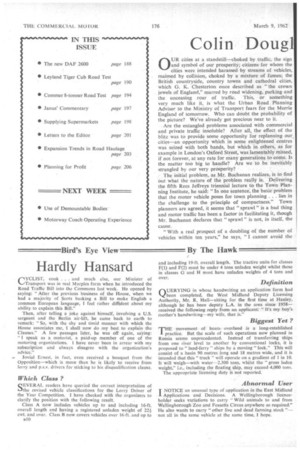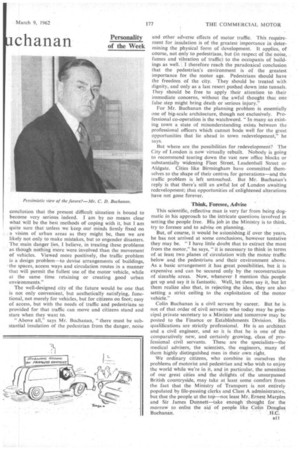Cohn Doug chanan
Page 44

Page 45

If you've noticed an error in this article please click here to report it so we can fix it.
OUR cities at a standstill—choked by traffic, the sign and symbol of our prosperity; citizens for whom the cities were intended harassed by streams of vehicles, maimed by collision, choked by a mixture of fumes; the British countryside, country towns and cathedral cities, which G. K. Chesterton once described as "the crown jewels of England," marred by road widening, parking and the unceasing roar of traffic. This, or something very much like it, is what the Urban Road Planning Adviser to the Ministry of Transport fears for the Merrie England of tomorrow. Who can doubt the probability of the picture? We've already got -precious near to it.
. Are the entangled problems associated with commercial and private traffic insoluble? After all, the effect of the blitz was to provide some opportunity for replanning our, cities—an opportunity which in some enlightened centres was seized with both hands, but which in others, as for example in London's Oxford Street, was lamentably missed, if not forever, at any rate for many generations to come. Is the matter too big to handle? Are we to be inevitably strangled by our very prosperity?
The initial problem,. as Mr. Buchanan realizes, is to find out what the nature of the problem really is. Delivering the fifth Rees Jeffreys triennial lecture to the Town Planning Institute, he said: "In one sentence, the basic problem that the motor vehicle poses for town planning . . • lies in the challenge to the principle of compactness." Town planners are agreed, it seems that " sprawl " is a bad thing and motor traffic has been a factor in facilitating it, though Mr. Buchanan declares that " sprawl" is not, in itself, the
cause.
"With a real prospect of a doubling of the number of vehicles within ten years," he says, "I cannot avoid the conclusion that the present difficult situation is bound to become very serious indeed. I am by no means clear what will be the best methods of coping with it, but I am quite sure that unless we keep our minds firmly fixed on a vision of urban areas as they might be, then we are likely not only to make mistakes, but to engender disasters. The main danger lies, I believe, in treating these problems as though nothing more were involved than the movement of vehicles. Viewed more positively, the traffic problem is a design problem—to devise arrangements of buildings, • the spaces, access ways and circulation routes in a manner that will permit the fullest use of the motor vehicle, while at the same time retaining or creating good urban environments."
The well-designed city of the future would be one that is not only convenient, but aesthetically satisfying, functional, not merely for vehicles, but for citizens on foot; easy of access, but with the needs of traffic and pedestrians so provided for that traffic can move and citizens stand and stare when they want to.
'Above all," says Mr. Buchanan, "there must be substantial insulation of the pedestrian from the danger, noise
and other adverse effects of motor traffic. This requiren-ient for insulation is of the greatest importance in determining the physical form of development. It applies, of course, not only to pedestrians, but (in respect of the noise, fumes and vibration of traffic) to the occupants of buildings as well. I therefore reach the paradoxical conclusion that the pedestrian's environment is of the greatest importance for the motor age. Pedestrians should have the freedom of the city. They should be treated with dignity, and only as a last resort pushed down into tunnels. fhey should be free to apply their attention to their immediate concerns, without the awful thought that one false step might bring death or serious injury."
For Mr. Buchanan the planning problem is essentially one of big-scale architecture, though not exclusively. Professional co-operation is the watchword. "In many an existing town a state of misunderstanding exists between the professional officers which cannot bode well for the great opportunities that lie ahead in town redevelopment," he says.
But where are the possibilities for redevelopment? The City of London is now virtually rebuilt. Nobody is going to recommend tearing down the vast new office blocks or substantially widening Fleet Street, Leadenhall Street or Aldgate. Cities • like Birmingham have committed themselves to the shape of their centres for generations—and the traffic problem is left untouched. But Mr. Buchanan's reply is that there's still an awful lot of London awaiting redevelopment; that opportunities of enlightened alterations have not gone forever.
Think, Foresee, Advise This scientific, reflective man is very far from being dogmatic in his approach to the intricate questions involved in setting the people free. His job in the Ministry is to think, try to foresee and to advise on planning.
But, of course, it would be astonishing if over the years, he has not arrived at some conclusions, however tentative they may be. "I have little doubt that to extract the most from the motor," he says, "it is necessary to think in terms of at least two _planes of circulation with the motor traffic below and the pedestrians and their environment above. As a basic arrangement it has great possibilities, but it is expensive and can be secured only by the reconstruction of sizeable areas. Now, whenever I mention this people get up and say it is fantastic. Well, let them say it, but let them realize also that, in rejecting the idea, they are also setting a strict ceiling to the exploitation of the motor vehicle."
Colin Buchanan is a civil servant by career. But he is not of that order of civil servants who today may be principal private secretary to a Minister and tomorrow may be posted to the Finance or Establishments Division. His qualifications are strictly professional. He is an architect and a civil engineer, and so it is that he is one of the comparatively new, and certainly growing, class of professional civil servants. These are the specialists—the medical advisers, the scientists, the engineers, many of them highly distinguished men in their own right.
We ordinary citizens, who combine in ourselves the problems of motorist and pedestrian and who wish to enjoy the world while we're in it, and in particular, the amenities of our great cities and the delights of the unsurpassed British countryside, may take at least some comfort from the fact that the Ministry of Transport is not entirely populated by file-passing clerks and Class A administrators, but that the people at the top—not least Mr. Ernest Marples and Sir James Dunnett—take enough thought for the morrow to enlist the aid of people like Cohn Douglas
Buchanan. • H.C.




































































































































